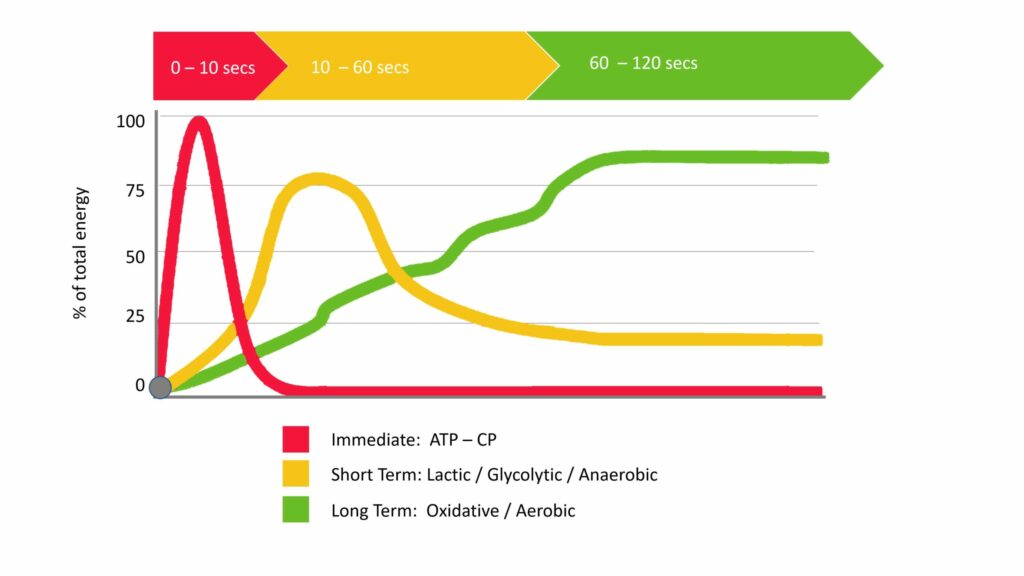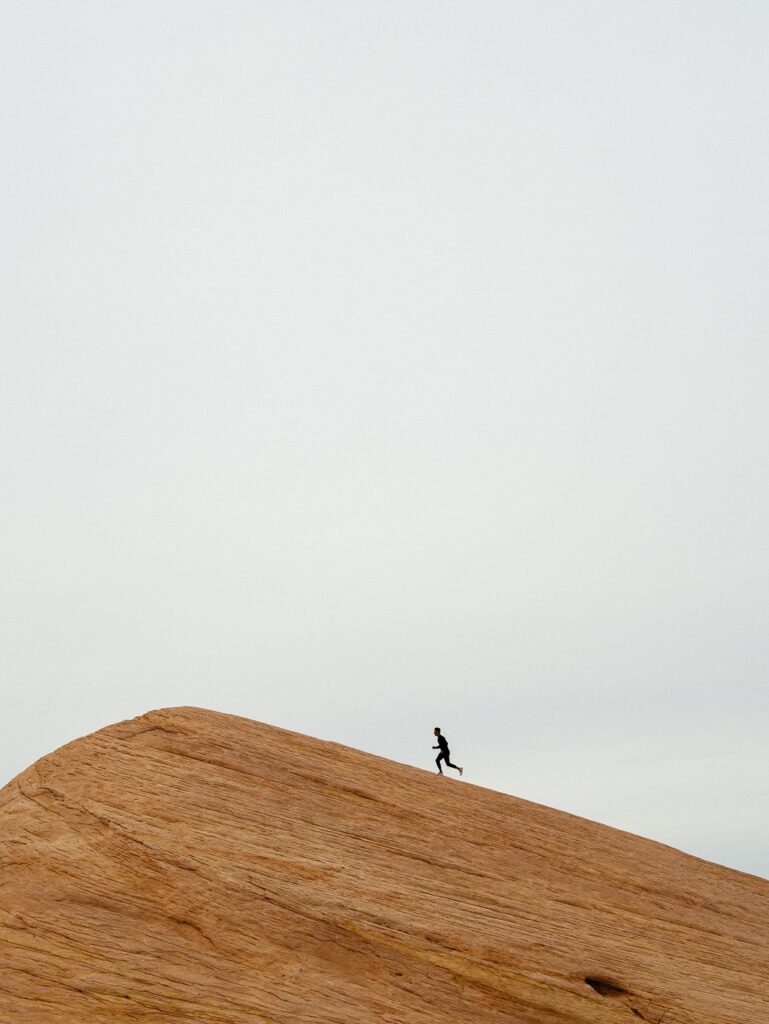Rock climbers can run but it isn’t necessary. Running can bring cardiovascular benefits to rock climbing, and in specific situations can help you to stay fit.
How and why, you should or shouldn’t run as a rock climber I explain in this blog.
I start with a quick intro to the energy systems of the body, which will help you to understand the reasoning behind my final verdict on whether “Rock Climbers should Run” at the end of this article.
1. A Short Introduction to Energy Systems
There are 2 ways in which your body produces adenosine triphosphate (ATP), the energy molecule for your muscles:
- Anaerobic energy production: making energy without oxygen
- Aerobic energy production: making energy with the help of oxygen
The anaerobic energy systems (there are two of them) produce energy in the first minute of activity and are required for short explosive activities.
The aerobic system starts as soon as you initiate movement but only becomes the main source of energy after a minute of activity.
I’ll now discuss the energy systems in more detail.
1.1 Anaerobic Alactic (ATP-CP) System
Muscles store a small amount of ATP which is quickly depleted during strenuous exercise and might only fuel you for 2 seconds. In response to the depletion of ATP creatine phosphate (CP), which also resides in your muscles, breaks down into creatine and phosphate which molecules will then serve as an energy source to resynthesize ATP.
The anaerobic alactic system provides energy up to 10 seconds into activity.
1.2 Anaerobic Lactic System
After the anaerobic alactic energy supply is used up, the anaerobic lactic system becomes the main energy supplier. In this case, glycogen (the sugar stored in your muscles and liver) is used to make ATP. In this energy system, lactic acid forms as a by-product. When lactate builds up in the muscles you experience fatigue and a reduction of power output.
The anaerobic lactic system is the main energy supply up to 60 seconds into an activity.
1.3 Aerobic System
After about a minute the aerobic system becomes the main source of energy production. Fuel for this system is glycogen, protein, and fat.
Due to the presence of oxygen, glycogen can now be turned into ATP without significant lactate build-up allowing you to continue exercise without getting tired. After about 2 hours your body switches from breaking down glycogen to breaking down fat and protein. This is the moment you encounter “the man with the hammer”. The moment you feel tired in an endurance effort, but as soon as your body switches to breaking down fat, you’ll have renewed energy.
The aerobic system is the main energy supply for all activities lasting more than 60 seconds.

2. What Training Effect Does Running Have on Your Body?
It depends on the time you run, what training effect this running has on your body.
- Short sprints will develop your alactic anaerobic energy system (< 10 seconds) and require maximum strength and power.
- 100–200-meter runs will develop the lactic anaerobic energy system and require maximum strength, power, and power endurance (10 – 60 seconds)
- Runs longer than a minute train your aerobic energy system and require maximum strength, power, power endurance, and muscle endurance.
The energy systems you train, and the adaptations that come as a result to your heart, joints, muscles, and tendons are best for running. This is called specificity; training adaptations from running are best for running. That does make sense, doesn’t it?
So, assuming you run anywhere from 15 to 60 minutes your leg muscles develop muscular endurance and you train your aerobic energy system. The other strength qualities, power, power endurance, and max strength can be trained more efficiently with strength training than by running itself.
Are you still with me? Diving this deep into running will help you understand how relevant running actually is for rock climbers.
So, now let’s have a look at what training adaptations you need for rock climbing.
3. What Type of Fitness does Rock Climbing Require?
Just like with running, it depends on your type of rock climbing and/or bouldering which training adaptations you get in the body.
- Short boulders train the alactic anaerobic energy system and require max strength and power.
- Longer boulder problems train the lactic anaerobic energy system and require max strength, power, power endurance, and muscle endurance short
- Sport routes train the aerobic energy system and require max strength, power, power endurance, and muscle endurance medium to long
And again, similar to running, the training adaptations that happen as a result of bouldering and rock climbing are best for bouldering and rock climbing. Thus, as a boulderer or rock climber, you’ll develop either one of the relevant energy systems to your discipline. And you’ll be training the strength qualities for your upper body, your finger-, forearm-, upper-arm-, shoulder-, and back muscles.
Running for distance on even terrain trains the aerobic energy system predominantly. This is different from rock climbing. The crux of a route might require you to make a couple of powerful moves (alactic anaerobic), followed by a couple of easier moves that last another 30 seconds (lactic anaerobic). Luckily, the final 2 minutes of the climb are well within your limits (aerobic energy system).
All routes are different though and therefore require a unique set of capabilities. The closer you climb to your limit the longer you want to be able to use both your alactic and lactic energy systems. Because these provide a lot of ATP at once which allows you to make powerful moves.
Do you now have an idea of the training adaptations that follow from, and are required for running and rock climbing?
Then, let’s now discuss how running can benefit rock climbing.
4. How can Running Benefit Rock Climbers?
Due to the concept of variability, the opposite of specificity, adaptations acquired with one activity can transfer to another activity. In this case from running to climbing. More specifically, running can benefit rock climbing in 5 ways:
- General Conditioning: regular runs will develop muscle endurance in the legs and will enhance the aerobic energy system. You’ll benefit from both while rock climbing.
- Short Sprints (Uphill Preferably): short sprints develop your anaerobic energy systems and, if you do them uphill, have an added strength benefit. Generating force with your legs by pushing through the ground is something you want to be good at while climbing and/or bouldering too. So, if you do hill runs, focus on pressing up through your toes. The fact that you’re doing this consciously can help you do the same while climbing.
- Mindset: pushing yourself to go running and then to run far can develop a mindset that helps you to push yourself out of your comfort zone. Something you have to do often when rock climbing.
- Weight management: long slow distance runs are a solid strategy to burn fat which you might be looking to do to increase your short-term rock climbing performance (a bodyweight that is too low though, will hurt your health and therefore also your rock climbing performance in the long run).
- Maintaining a rhythm: a crag to rock climbing or a climbing- or boulder gym might not always be at your disposal. A run, on the contrary, can be done anywhere at any time. City, countryside, morning or night, and without a partner. Therefore, running might be a valid option to stay fit, definitely when you can’t climb more than 2x a week.
Now, let’s see how running might reduce rock climbing performance.

